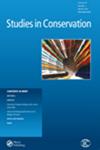来自北领地和西澳大利亚金伯利地区的土著艺术家在树皮画中使用的颜料和粘合剂
IF 0.8
4区 化学
0 ARCHAEOLOGY
引用次数: 0
摘要
树皮画代表了一种独特的艺术形式,起源于澳大利亚,一直延续到今天。本文介绍了一项科学调查,研究了来自北领地(NT)和西澳大利亚(WA)金伯利地区的土著艺术家使用的颜料和粘合剂,并代表了第一个致力于从绘画样本中识别这些材料的主要研究。利用激光烧蚀-电感耦合等离子体质谱(LA-ICP-MS)、傅里叶变换红外光谱(FTIR)和拉曼光谱(Raman spectroscopy)对原住民艺术家作品中常见的红、黄、黑、白四种颜色中的颜料进行了鉴定。氧化铁用于制作红色和黄色。通常,高岭土用于白色,碳或天然锰矿石用于黑色,尽管在特定地点的绘画中可以看到使用其他颜料,如狩猎石(白色)和电池黑。在这项研究中无法确定贸易的证据;然而,分析表明,艺术家可能会根据地点和可用性使用不同的颜料。利用FTIR和热解-气相色谱-质谱联用(热解-气相色谱-质谱联用)对涂料中粘合剂的存在进行了研究。植物基材料被确定为大多数画作的粘合剂。兰花汁的使用是常见的,既作为树皮基材上的预备层,也作为油漆粘合剂。合成树脂的出现比预期的更广泛,这要归功于保护工作和更现代的绘画实践。本文章由计算机程序翻译,如有差异,请以英文原文为准。
Pigments and Binders Used in Bark Paintings by Aboriginal Artists from Across the Northern Territory and the Kimberly Region in Western Australia
Bark paintings represent a unique artform that originated in Australia and continues to this day. This paper presents a scientific investigation into both the pigments and binders used by Aboriginal artists from across the Northern Territory (NT) and the Kimberley region in Western Australia (WA) and represents the first major study dedicated to identifying these materials in samples taken from paintings. Laser ablation-inductively coupled plasma-mass spectrometry (LA-ICP-MS), Fourier transform infrared (FTIR) and Raman spectroscopy were used to identify the pigments in the four colors commonly associated with works by Aboriginal artists: red, yellow, black, and white. Iron oxides are used for red and yellow. Typically, kaolin is used for white and carbon or natural manganese ores are used for black, although the use of other pigments such as huntite (white) and battery black were seen in paintings from specific locations. Evidence of trade could not be established during this study; however, analysis shows that artists may use different pigments based on location and availability. A combination of FTIR and pyrolysis-gas chromatography-mass spectrometry (pyrolysis-GC-MS) was utilized to investigate the presence of a binder in the paint. Plant-based materials were identified as the binder in the majority of the paintings. The use of orchid juice was common, both as a preparatory layer on the bark substrate and as a paint binder. The presence of synthetic resins was more widespread than anticipated, attributed to both conservation efforts and more modern painting practices.
求助全文
通过发布文献求助,成功后即可免费获取论文全文。
去求助
来源期刊

Studies in Conservation
化学-分析化学
CiteScore
1.80
自引率
12.50%
发文量
73
审稿时长
>12 weeks
期刊介绍:
Studies in Conservation is the premier international peer-reviewed journal for the conservation of historic and artistic works. The intended readership includes the conservation professional in the broadest sense of the term: practising conservators of all types of object, conservation, heritage and museum scientists, collection or conservation managers, teachers and students of conservation, and academic researchers in the subject areas of arts, archaeology, the built heritage, materials history, art technological research and material culture.
Studies in Conservation publishes original work on a range of subjects including, but not limited to, examination methods for works of art, new research in the analysis of artistic materials, mechanisms of deterioration, advances in conservation practice, novel methods of treatment, conservation issues in display and storage, preventive conservation, issues of collection care, conservation history and ethics, and the history of materials and technological processes. Scientific content is not necessary, and the editors encourage the submission of practical articles, review papers, position papers on best practice and the philosophy and ethics of collecting and preservation, to help maintain the traditional balance of the journal. Whatever the subject matter, accounts of routine procedures are not accepted, except where these lead to results that are sufficiently novel and/or significant to be of general interest.
 求助内容:
求助内容: 应助结果提醒方式:
应助结果提醒方式:


